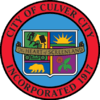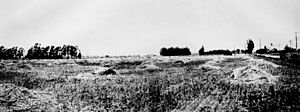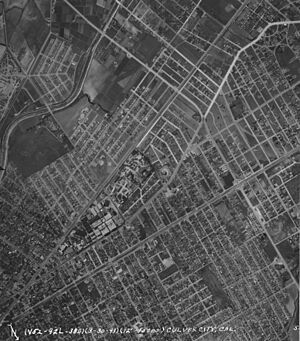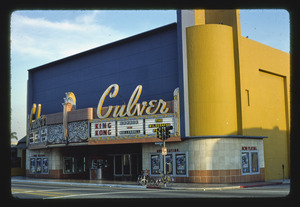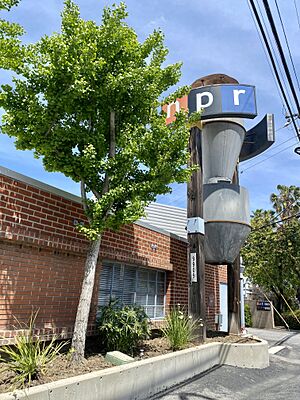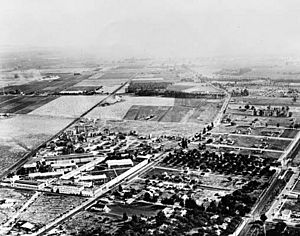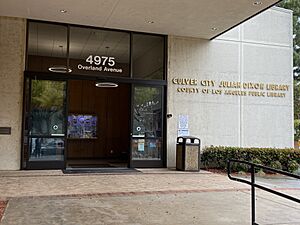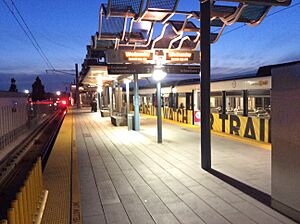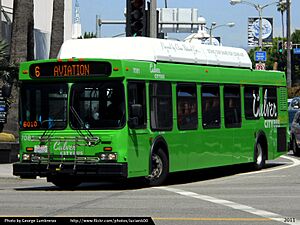Culver City, California facts for kids
Quick facts for kids
Culver City, California
|
|||
|---|---|---|---|
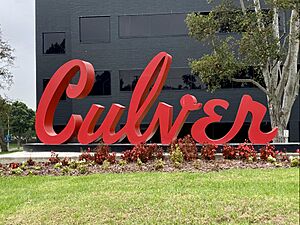
Culver City sign based on the marquee of the Culver Theatre (now Kirk Douglas Theatre)
|
|||
|
|||
| Motto(s):
"The Heart of Screenland"
|
|||
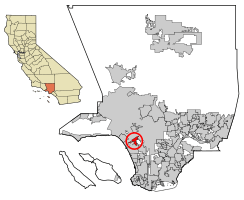
Location within Los Angeles County
|
|||
| Country | United States | ||
| State | California | ||
| County | Los Angeles | ||
| Incorporated | September 20, 1917 | ||
| Named for | Harry Culver | ||
| Government | |||
| • Type | Council-Manager | ||
| Area | |||
| • Total | 5.14 sq mi (13.31 km2) | ||
| • Land | 5.11 sq mi (13.24 km2) | ||
| • Water | 0.03 sq mi (0.07 km2) 0.54% | ||
| Elevation | 95 ft (29 m) | ||
| Population
(2020)
|
|||
| • Total | 40,779 | ||
| • Density | 7,977.11/sq mi (3,080.15/km2) | ||
| Time zone | UTC−8 (Pacific Time Zone) | ||
| • Summer (DST) | UTC−7 (PDT) | ||
| ZIP Codes |
90230–90232, 90066
|
||
| Area codes | 310/424 | ||
| FIPS code | 06-17568 | ||
| GNIS feature IDs | 1652695, 2410276 | ||
Culver City is a city in Los Angeles County, California, United States. As of the 2020 census, about 40,779 people live there. It is mostly surrounded by the large city of Los Angeles. It also shares a border with Ladera Heights to the east.
The city was named after its founder, Harry Culver. He first tried to start the city in 1913. In the 1920s, Culver City became a major spot for making movies and later TV shows. It was famous for being the home of Metro-Goldwyn-Mayer (MGM) studios for many years. Today, National Public Radio West and Sony Pictures Entertainment have their main offices in the city.
Contents
Discovering Culver City's Past
How Culver City Began
People have lived in the Culver City area for a very long time. Evidence shows humans were here as early as 8000 BCE. The Tongva-Gabrieliño Native Americans were the original inhabitants. For centuries, they lived in and around what is now Culver City.
Later, Spanish and Mexican governments gave out large pieces of land. Culver City was founded on parts of these old land grants. These were called Ranchos of California, specifically Rancho La Ballona and Rancho Rincon de los Bueyes. When Culver City was first founded, certain groups of people were not allowed to buy property there.
During the American Civil War, a U.S. Army camp called Camp Latham was set up here. This was from 1861 to 1862, near Ballona Creek.
Founding the City
Harry Culver officially started Culver City on September 20, 1917. He named it after himself. The city grew quickly because it already had good transportation routes. Harry Culver's early advertisements even said, "All roads lead to Culver City."
The first newspaper in the community was the Culver City Call, started in 1915.
The Rise of Movie Studios
The first film studio in Culver City was built by Thomas Ince in 1918. Silent film producer Hal Roach built his studios there in 1919. Then, Metro Goldwyn Mayer (MGM) took over the Triangle studio in 1924. During the time of Prohibition, when alcohol was illegal, many secret bars and nightclubs opened along Washington Boulevard.
Culver Center, one of the first shopping malls in Southern California, opened in 1950.
Hughes Aircraft Company's Role
Hughes Aircraft opened its plant in Culver City in 1941. This is where they built the huge H-4 Hercules transport plane, often called the "Spruce Goose." Hughes also helped a lot during World War II. They made parts for machine guns and aircraft.
After the war, the company grew even more. In 1953, Howard Hughes gave all his company shares to the Howard Hughes Medical Institute.
Changes in the Studio World
The Hal Roach Studios were torn down in 1963. In the late 1960s, much of the MGM studio land was sold. Other studio properties, like the RKO Forty Acres, were also sold. By 1976, these old movie sets were removed to make way for new buildings. Today, these areas have new homes and shopping centers.
In October 1975, the Fox Hills Mall opened where a golf course used to be.
Downtown's New Look
In the early 1990s, Culver City started a big project to make its downtown area new and exciting. They also improved several shopping centers. Around the same time, Sony's movie companies, Columbia Pictures and TriStar Pictures, moved into the old MGM lot. This became Sony Pictures Studios.
Many art galleries and restaurants also opened in the eastern part of the city. This area is now known as the Culver City Art District.
Exploring Culver City's Location
Culver City is surrounded by many neighborhoods of Los Angeles. These include Mar Vista and Palms to the north, and Westchester to the south. To the east are Mid-City, West Adams, and Baldwin Hills. To the west, you'll find Venice and Playa Vista.
A main natural feature of Culver City is Ballona Creek. This creek flows through most of the city and eventually reaches Santa Monica Bay.
The city covers about 5.1 square miles (13.3 square kilometers). Over the years, Culver City has added more than 40 nearby pieces of land to its area.
City Neighborhoods
Culver City has 15 recognized neighborhoods:
- Blair Hills
- Blanco-Culver Crest
- Clarkdale
- Culver West
- Downtown Culver City
- Fox Hills
- Jefferson
- Lucerne-Higuera
- McLaughlin
- McManus
- Park East (also known as Carlson Park)
- Park West (also known as Veterans Park)
- Studio Village
- Sunkist Park
- Washington Culver
Weather in Culver City
Culver City has a mild climate. Summers are warm and dry, while winters are cool and wet. The average high temperature in January is about 66°F (19°C). In August, it's around 79°F (26°C). The city gets most of its rain in the winter months.
People and Population
| Historical population | |||||||||||
|---|---|---|---|---|---|---|---|---|---|---|---|
| Year | 1920 | 1930 | 1940 | 1950 | 1960 | 1970 | 1980 | 1990 | 2000 | 2010 | 2020 |
| Pop. | 503 | 5,669 | 8,976 | 19,720 | 32,163 | 34,451 | 38,139 | 38,793 | 38,816 | 38,883 | 40,779 |
| ±% | — | +1027.0% | +58.3% | +119.7% | +63.1% | +7.1% | +10.7% | +1.7% | +0.1% | +0.2% | +4.9% |
| U.S. Decennial Census | |||||||||||
Who Lives in Culver City?
In 2020, the population of Culver City was about 40,779 people. The city is home to a diverse mix of people. Many different ethnic groups and backgrounds make up the community.
Culver City's Economy
Many companies have their main offices in Culver City. These include Beats Audio, MedMen, NantHealth, Sweetgreen, and Sony Pictures Entertainment.
Top Employers
The biggest employers in Culver City include:
| # | Employer | # of Employees |
|---|---|---|
| 1 | Sony Pictures Entertainment | 3,000 |
| 2 | Westfield Culver City | 1,500 |
| 3 | Southern California Hospital at Culver City | 1,116 |
| 4 | NFL Media | 957 |
| 5 | City of Culver City | 808 |
| 6 | Culver City Unified School District | 800 |
| 7 | West Los Angeles College | 739 |
| 8 | Goldrich & Kest Industries, LLC | 670 |
| 9 | Target | 507 |
Movie and TV Production
Hundreds of movies have been made at the studios in Culver City. These include Sony Pictures Studios (which used to be MGM Studios) and Culver Studios. The former Hal Roach Studios were also here. In 2017, Amazon MGM Studios announced plans to build a new studio in Culver City.
Local Businesses
Some well-known businesses and places in Culver City are:
- Westfield Culver City, a large shopping mall.
- Beats Electronics, a company known for headphones.
- Disney Digital Network.
- NPR West, a branch of National Public Radio.
- Sony Pictures Studios, a major movie studio.
- The Ripped Bodice, a unique bookstore focusing on romance novels.
Arts, Culture, and Fun
Museums to Visit
The Wende Museum has a collection of art and everyday items from the Soviet Union and East Germany. It helps people understand the history and culture of that time. The Museum of Jurassic Technology is another interesting place. It has many exhibits that mix facts with fun stories.
Library
The County of Los Angeles Public Library runs the Julian Dixon Culver City Branch. It's a great place to find books and learn.
Cool Buildings and Architecture
Culver City has many interesting buildings. They show its history as a film center and a place for new designs. You can see styles from the early 1900s to modern times. Some famous buildings include:
- Ivy Substation (1907): A beautiful building that now hosts a theater group.
- Culver Studios (1918–1920): Offices designed like a grand old mansion.
- Culver Hotel (1924): A unique six-story brick building.
- Helms Bakery (1930): An old bakery with a special architectural style.
- Kirk Douglas Theatre (1946): A historic theater.
- St. Augustine Catholic Church (1957): A church built in a Gothic style.
- Robert Frost Auditorium (1963-64): Located at Culver City High School, this building has a unique scallop shell shape. It's a modern landmark for the city.
- Platform (2016): A modern shopping center.
Parks and Recreation
The City of Culver City has a Parks and Recreation department. They manage 14 outdoor parks within the city limits. These parks offer many places for sports, play, and relaxation.
Education in Culver City
Public Schools
The Culver City Unified School District runs these public schools:
- Culver City High School
- Culver City Middle School
- Culver City Unified School District iAcademy
- Culver Park High School
- El Marino Elementary School
- El Rincon Elementary School
- Farragut Elementary School
- La Ballona Elementary School
- Linwood E. Howe Elementary School
Private Schools
Some private schools in Culver City include:
- STAR Prep Academy: A middle and high school that shares its campus with an animal rescue center.
- The Willows Community School.
- Turning Point School.
- Kayne Eras Center (for students with disabilities).
- Wildwood School.
- Echo Horizon School.
Colleges
- Antioch University Los Angeles: A college in Culver City's Corporate Pointe area.
Media and Entertainment
Local Newspaper
- Culver City Call is the local newspaper.
Movies Made Here
Many famous movies have been filmed or partly filmed in Culver City, including:
- The Wizard of Oz
- Gone with the Wind
- King Kong
- Grease
- E.T. the Extra-Terrestrial
- Air Force One
- Superbad
- Moneyball
TV Shows Made Here
Many popular TV shows have also been filmed or partly filmed in Culver City, such as:
- Jeopardy!
- Gunsmoke
- Lassie
- Batman
- Arrested Development
- The Andy Griffith Show
- Wheel of Fortune
- The Wonder Years
Getting Around Culver City
Public Transportation
The Culver City station is part of the Los Angeles Metro E Line. This light rail line connects Culver City to Downtown Los Angeles and Santa Monica.
Culver CityBus started in 1928. It is one of the oldest city bus lines in California. It runs seven regular bus lines and a shuttle in downtown.
The Culver City Transit Center is a bus hub at the Westfield Culver City mall. It serves several Culver CityBus and Metro bus lines.
Bike Paths
Culver City has several bike paths for cycling:
- Culver Boulevard Median bike route
- Ballona Creek bike path, which connects to the Park to Playa Trail
- Elenda Street bikeway
- Bike and bus lanes in downtown Culver City
Air Travel
The city is served by the Los Angeles International Airport. This airport is about 7 miles (11 km) south of Culver City.
Freeways
Major freeways near Culver City include Interstate 405, Interstate 10, and California State Route 90.
Cemeteries
- Hillside Memorial Park Cemetery
- Holy Cross Cemetery
Famous People from Culver City
Many well-known people have lived in or are from Culver City:
- Drew Barrymore, actress
- Jack Black, actor
- Jackson Browne, singer
- Gary Carter, baseball player
- Helen Hunt, Oscar-winning actress
- Taran Killam, actor and comedian
- Michael Richards, actor and comedian
Sister Cities
Culver City has several sister cities around the world:
 Capo d'Orlando, Italy
Capo d'Orlando, Italy Iksan, South Korea
Iksan, South Korea Kaizuka, Japan
Kaizuka, Japan Lethbridge, Canada
Lethbridge, Canada Uruapan, Mexico
Uruapan, Mexico
See also
 In Spanish: Culver City para niños
In Spanish: Culver City para niños



